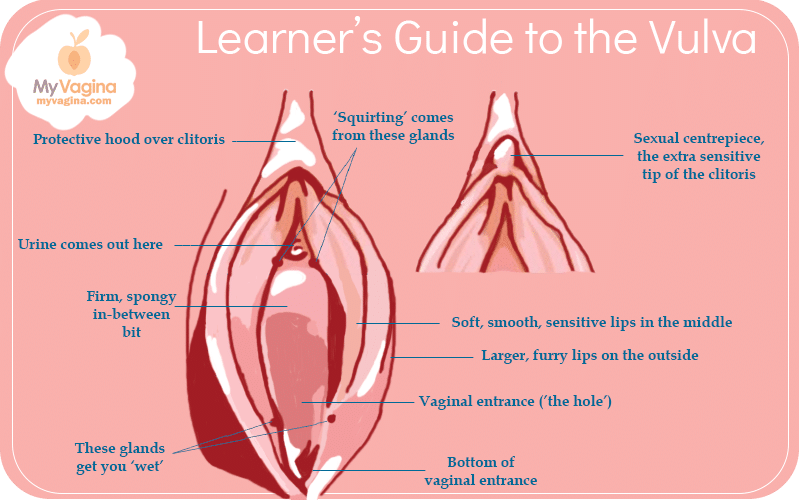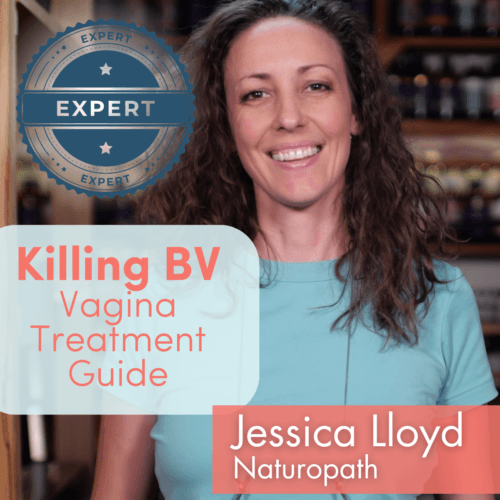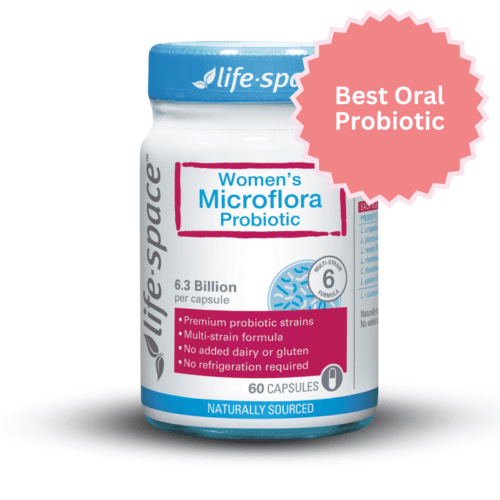Getting to know your vulva takes a little bit of time and getting all touchy-feely. Here is a guide to figuring it out faster so you can get more out of your body.
What is the purpose of the vulva?
Your vulva serves three important functions:
- protection of delicate tissue from outside influences via the lips (labia)
- Sexual sensation and function (clitoris, labia)
- The join to the anus, the perineum, which stretches to allow childbirth
Examining your vulva
The vagina is the inside part, while the vulva is the outside, so from now on, we’ll be referring to these separate parts by their real names.
Vagina = inside
Vulva = outside
The vulva includes the labia (inner and outer), the glans of the clitoris, the vestibule, and the introitus (entrance).
You can see the inner and outer lips and the tiny tip of the clitoris, but you can’t see the inside of the vagina from outside (without trying).
The inner lips protrude out of the outer lips and vary widely in size, shape, and colour from woman to woman.
The outer lips (labia majora) are covered in pubic hair, while the inner labia (labia minora) are smooth and soft, and perhaps a little wrinkly.
Get yourself a mirror, and find all the marked areas on your vulva.

Find your:
- Outer labia
- Inner labia
- The clitoris
- The clitoral hood
- Your urinary meatus – the exit of your urethra where urine comes out
- The vaginal opening (introitus)
- The vestibule, which is the area of flesh between the inner labia that connects the clitoris and the vaginal entrance, and contains the urethra, small glands, and the vagina at the bottom.
- The mons, which is the area immediately above your vulva covered in pubic hair, a fatty mound that protects you
- Pubic hair, which can spread far and wide (up between the buttocks, around the anus, and the upper inner thigh)
The outer labia
The outer labial skin contains glands for sweat and sebum and has hair follicles.
Sebum acts as a protectant from blood, urine, and bacteria, so don’t wash it all off with harsh, drying soaps. You may find this sebum in between your labial folds, and it looks waxy and white or a bit yellow. If it’s left there for too long, it will start to smell.
There are a lot of sweat glands in the vulva because it’s full of blood vessels. Blood brings heat, therefore we sweat. Sweat can cause odours, so be clear about what you’re blaming if you have vaginal odour.
The area between the inner and outer labia are the interlabial folds, which can contain little bumps, can itch, or have aches and pains.
It’s good to know the names of everything so you can talk about it with your doctor if you have issues.
The inner labia
The labia minora are darker than the other vulvar skin – they can be dark red, brownish, or deep pink, and every woman is a bit different. All inner labia are different, may not match, and may be large or small.
Little bumps may appear due to the little glands in the skin. These little bumps ares normal and keeps the labia supple and stops the lips from sticking, drying out, or rubbing together.
If you didn’t have your labia minora, urine would go everywhere when you peed. Your inner labia have their own secret sexy life too, being full of nerve-endings (which is why getting them cut off may be a bad idea).
With sexual arousal, the labia fill with blood and increase arousal. This makes everything feel better.
The clitoris, clitoral hood, frenulum, and fourchette
The small fold at the top under the clitoris where the labia split off is the frenulum, the same sort as underneath your tongue.
Above this is your clitoral hood, protecting the most sensitive part of your body, your clitoris. Some inner labia split off twice here.
Where the labia minora join at the bottom of the vaginal entrance is called the fourchette.
If you’ve given birth vaginally, this may flatten out and become less pronounced.
The vestibule
This part of your anatomy is different from the other parts of the vulva and has a different function.
The vestibule is the area between the labia minora (inner labia), the smooth triangle. The upper vestibule houses your urethra and the lower vestibule holds your vagina.
There are a glands on the vestibule – the Skene’s glands and ducts, which are the female prostate and where some women can ejaculate from (‘squirting’).
The vestibule is moist, has many nerve endings, and is quite glandular. The vestibule is used during sexual arousal when some of its many blood vessels fill with blood, with the bulbs of the vestibule becoming erect and firm.
The vestibular bulbs surround the urethra, and this area is often referred to as the ‘g-spot’. The vestibule flesh is more like the mouth – a wet, raw mucous membrane.
The clitoris
Your clitoris is actually quite huge and has legs and arms that dive into your body. The little bud on the outside is just a fraction of your true clitoris.
The shaft connects to the pubic bone, then divides into two to form the crura, wishbone-shaped tissue that are up to 9cm (3.5 inches) across. The roots and shaft are covered by muscle.
The clitoral glans – the nub on the outside – contains thousands of nerves, which is why the clitoris is so sensitive, almost painful sometimes, to touch.
The shaft has very few nerve endings, but blood vessels push it outwards when you are sexually aroused.
The clitoris and the penis, while sharing much the same tissues, have some key differences. The clitoris does not become rigid like the penis, because the network of blood vessels that facilitate this do not exist, however instead, the clitoris can take in and let go of blood fluidly to make it tumescent (firm). A penile erection by comparison is ‘stuck’ for a bit.
This process is how women can achieve multiple orgasms, but also how sexual arousal can be more temporary.
The clitoris has no other function but sexual pleasure. There are a couple of important nerves – the vagus nerve and the pudendal nerve – that create the full range of sexual pleasures, including from anal sex.
Read more about the clitoris here.
The hymen
The hymen is a thin membrane that covers the vaginal opening when girls are born. It has no known biological function and tends to disappear at adolescence.
Read more about the hymen here.
Hymenal tags or remnants are left, sometimes protruding a bit out of the vaginal entrance, and is normal.
The perineum
The perineum stretches between the anus and the vaginal entrance. In some people, the perineum is short, which can contribute to more frequent infections, as bacteria from the colon gets into the vagina and urethra.
The perineum is the part cut during some labours to assist with childbirth (episiotomy).
Checking yourself out
It’s important to explore and get to know your own body. Make the time for it, get yourself in a private comfortable position with a hand mirror, a torch or lamp with a flexible head, and possibly even your smartphone camera (to avoid a crick in your neck!), and let’s get into it.
You may feel like your vagina and vulva look ‘funny’ or ‘ugly’. This is just because you’re not used to looking at it, and it is indeed very fleshy and pink and wrinkly and funny!
Check out the Labia Library. You will quickly find there are many shapes and sizes, and yours will fit into the spectrum somewhere.
Put the mirror on the ground and straddle it as close as you can while you can get light onto your vulva so you can see it.
Try using the toilet with the lid down. Move this all around until the light is facing your vulva, the mirror is facing your vulva, and is close, and you have enough room to see.
If you are large, you may be better off using a long wall mirror – sit on the floor facing the mirror with your legs apart, and make sure the light shines on your vulva.
Fiddle around with this method or a hand mirror as feels comfortable and you can see.
You can also take a series of photographs, then load them onto a computer to get a better look without going to too much effort.
Make sure to touch your vulva while looking at the pictures to see what everything feels like. Each section feels different.
What you should find
Touching your vulva and vagina should not be painful, though your clitoris may be sensitive to touch – this is normal.
Touching your vulva may even turn you on – this is fine too! Woohoo! It should feel good to touch.
If you feel sharp or stabbing pains anywhere, you need to find a doctor who specialises in vaginas who can help you, because this is not normal and means something is wrong that needs treatment.
If you feel lumps and bumps that you haven’t read about here, check the site for specifics.
There are several glands that could have small blockages (Bartholin’s ducts or glands or Skene’s ducts or glands). These glands or ducts may be tender or painful.
You should be able to put at least one lubricated finger right inside your vagina (if the hymen is not there), without hitting anything, but if you do, it’s possible you have an unidentified anatomical abnormality like a septum or pelvic floor dysfunction.
Your vagina is going to provide you with endless well-kept secrets as you go through your life, so keep exploring! You’re not done yet.
References1–3
- 1.Krissi H, Ben-Shitrit G, Aviram A, et al. Anatomical diversity of the female external genitalia and its association to sexual function. European Journal of Obstetrics & Gynecology and Reproductive Biology. Published online January 2016:44-47. doi:10.1016/j.ejogrb.2015.11.016
- 2.Sokol AI, Shveiky D. Clinical Anatomy of the Vulva, Vagina, Lower Pelvis, and Perineum. GLOWM. Published online 2008. doi:10.3843/glowm.10000
- 3.Yavagal S, de Farias T, Medina C, Takacs P. Normal Vulvovaginal, Perineal, and Pelvic Anatomy with Reconstructive Considerations. Seminars in Plastic Surgery. Published online May 2011:121-129. doi:10.1055/s-0031-1281481
The most comprehensive vaginal microbiome test you can take at home, brought to you by world-leading vaginal microbiome scientists at Juno Bio.
Unique, comprehensive BV, AV and 'mystery bad vag' treatment guide, one-of-a-kind system, with effective, innovative treatments.
Promote and support a protective vaginal microbiome with tailored probiotic species.





